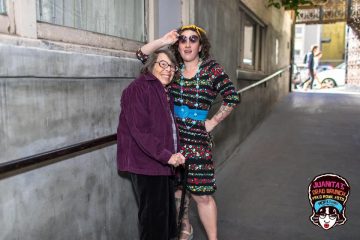Maya Angelou, San Francisco’s First African-American Female Streetcar Conductor

Photo: Pinterest
By Alex Szoenyi
The first African-American to pen a best-selling nonfiction book. The first African-American and first female to read a poem at a Presidential Inauguration. The first African-American female director. It seems that Dr. Maya Angelou was destined for a life of trailblazing firsts. Perhaps the initial, yet most obscure of these, she experienced in San Francisco.
In 1944, in the midst of WWII, a 16-year old Maya Angelou (then Johnson) had just moved to San Francisco to join her mother. Since she was late for enrollment in school, but was ahead in her schooling, mother Vivian told her she needed to get a job. According to her autobiography Mom & Me & Mom, Maya told her mother she wanted to be “a conductorette on a streetcar.” She was entranced by the female conductors and their “little moneychanging belts and with bibs on their caps and well-fitted uniforms.”
At that moment, all the conductors were white, yet that didn’t deter both Angelou and her mother from her dream. The company office refused to give her an application because she was black, but her mother was adamant that Maya go back and get her job. After two weeks of sitting in the office daily, waiting patiently, while reading books by Tolstoy and Dostoevsky, and dining at good restaurants during lunch, Angelou was given the job. “I had to lie, ‘I was a chaufferette for Mrs. Annie Henderson in Stamps, Arkansas,’” Angelou admits in her book. When the manager asked her why she wanted the job, she said, it was “because I like the uniforms, and I like people.”

Photo: Market Street Railway
Although MUNI was hiring African-American streetcar conductors by 1944, Angelou was initially considered the first African-American to hold the job (she is now regarded as the first African-American female.). Some of the same girls from George Washington High School that she would help with homework, and were now secretaries at Market Street Railway, would tease Maya, laugh at her appearance, and “whispered terrible words, racial pejoratives.”

Photo: San Francisco Public Library
Yet Angelou continued with her job until she left to return to school. She most likely worked on the 7-Haight, on a 100-class streetcar, built in 1911 by the Jewett Car Company. Her shift was from 4am to 8am, then from 1pm to 5pm, and began in Ocean Beach. From fighting so hard to even be considered for the job in the 1940s, fast forward 60 years later, in 2014, when Maya Angelou would receive a lifetime-achievement award from the Conference of Minority Transportation Officials, for fearlessly leading the way for others in the field of transportation.
As stated in her autobiography, Maya Angelou’s mother asked her what she learned from working as a streetcar conductor. She replied, “I learned I am not afraid to work, and that’s about all.” Her mother then declared, “No, you learned that you have power—power and determination. I love you and I am proud of you. With those two things, you can go anywhere and everywhere.”









